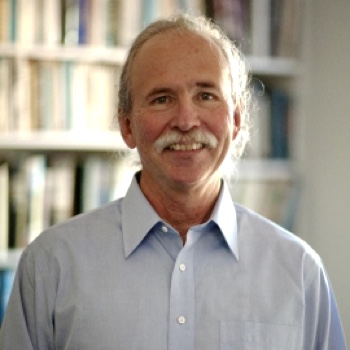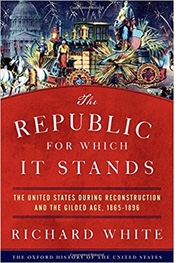What I’m Reading: An Interview with Stanford’s Richard White

Richard White is Margaret Byrne Professor of American History at Stanford University. He is the author of numerous prize-winning books, including Railroaded: The Transcontinentals and the Making of Modern America, The Middle Ground: Indians, Empires, and Republics in the Great Lakes Region, 1650-1815, and "It's Your Misfortune and None of My Own": A New History of the American West. He is a recipient of a MacArthur Fellowship, a Guggenheim Fellowship, and a Mellon Distinguished Scholar Award, among other awards. His latest book, The Republic for Which It Stands: The United States during Reconstruction and the Gilded Age, 1865-1896 (Oxford History of the United States), is now available.
 Why
did you choose history as your career?
Why
did you choose history as your career?
I’d credit my interest in history partially to Landmark Books. It was a series for young readers that I devoured as a child in New York before we moved to California. I particularly remember the books on American history and those written by Harold Lamb, things like Genghis Khan and the Mongol Horde. If I liked authors, I would read the books they wrote for adults. My father was not indulgent about many things, but I could buy as many books as I wanted if I read them. The books were on sale for a quarter or less in New York City used bookstores that we would visit from Long Island.
As for becoming an historian, I’d put most of the blame on the Nisqually Indians. I was active in the Indian fishing rights struggle at Frank’s Landing in Washington State in the late 1960s. The Nisqually were the most interesting people that I had ever met, and talked about events a century or more earlier as if they had happened yesterday. In trying to understand that past and how they thought about, I went to graduate school and wrote my master’s thesis on the Medicine Creek Treaty. It was flawed—I was learning to be a historian— but it had me starting to do research, and I have never stopped. In many ways, I am still happiest in the archives.
What qualities do you need to be a historian?
For starters: patience, imagination, humility, curiosity, and empathy. Historians need an eye for the bigger picture – they need to answer the “who cares?” question and explain why what they are writing about matters. But at the same time, they need to recognize the specific illuminating details that ground the past in a vivid lived experience.
What have you found most rewarding and most frustrating about your career?
I am an academic and so the short answer to both is universities. I have been at Stanford for nearly twenty years, but my heart is still with public institutions, which unfortunately with rising tuition and declining state contributions have become less and less public. At their best, universities offer an engagement not only with ideas but with larger public purposes. At their worst, they are narrow parochial institutions devoted largely to what will enhance their ability to raise funds and to creating an instrumental knowledge that largely serves the powerful.
The horrifying thing about universities is that you constantly grow older, while students never age. But the good thing – really a wonderful thing – is that they allow me to follow my own intellectual curiosity in the company of undergraduates, and particularly graduate students, of often astonishing ability.
How has the study of history changed in the course of your career?
It has changed largely for the better. Those who write and teach it are more diverse in all kinds of ways and the subjects they pursue and the questions they ask are far more varied and sophisticated than when I was in graduate school. The tools that I can deploy – particularly the kinds of digital tools used in the Spatial History Lab at Stanford, of which I am inordinately proud even though I have not directed it for years – allow historians to do things they simply could not do before. Many sources are now far more accessible. I can look at things in an afternoon sitting on a porch with a computer on my lap that would have taken me weeks and considerable travel when I started out.
All of this comes at a cost. The more diverse historical studies become, the harder they are to integrate at any level of meaningful detail. Although I admire many of the historians who write world history and deep history, I remain skeptical of these genres. As much as I appreciate the desire for integration and the ambition of the undertaking, both world and deep history operate at a scale that produces generalizations that I often find just vacuous and silly.
You are the author of an upcoming volume in the Oxford History of the United States entitled The Republic for Which It Stands: The United States during Reconstruction and the Gilded Age, 1865–1896. Can you talk briefly about how this book came about and what your central argument is?
There is a line in the movie version of The Wizard of Oz that I seem to find funnier than the people to whom I quote it. When the wizard is asked how he became the Great Oz, he sums it up by saying, “Times being what they were, I accepted the job.” When David Kennedy first offered me the chance to write the Gilded Age volume, I turned it down. Eventually, he offered again. By then my mother had dementia, was in a board and care, and looked like she would run out of money. Oxford offered a generous advance. Times being what they were, I accepted the job and the advance.
Once I started working on the book, I became absorbed by Reconstruction and the Gilded Age. The key question in the volume is how could Northern Republicans with such a clear vision of what they intended the United States to be and with such a firm hand on the levers of power end up living in a world they never imagined by the turn of the twentieth century?
In trying to explain this, I noticed that no matter what kind of change I looked at – social, political, demographic, economic, environmental and more – Americans argued about it in terms of the “home.” It was the grounding of their understanding of the world, and it became the central theme of the book.
Which book that you’ve read on the Civil War has impressed you most?
When I was a child I read all of Bruce Catton’s books on the Civil War, and the Civil War era has produced some of the best writing in American history, but I will confine myself to recent books. I will also broaden the question to include the years following the war. This is what Gregory Downs in After Appomattox: Military Occupation and the Ends of War has done, and I found his book very impressive and persuasive. It answered all kinds of nagging questions for me. I also very much like Chandra Manning’s new book, Troubled Refuge: Struggling for Freedom in the Civil War and Martha Hodes’s Mourning Lincoln. The Civil War is a subject which for years has been dominated by people with a Y chromosome, but it has now become the subject of powerful books written by women.
What was your experience writing a narrative history, and how did it compare with a traditional narrative? Do you have any techniques for immersing the reader in narrative history?
As I often tell my students, the past is not a story. Historians make it into a story, and finding a narrative thread through the late nineteenth century was not easy. I wanted to operate on a series of scales from the quotidian events of the era to the larger themes that only became visible later when historians could view the period as a whole. I also wanted to give a sense of how difficult it was for people living in the era to make sense of a world they were in the midst of making.
To do this, I needed characters who were both immersed in the everyday and thoughtful enough to try to consider a larger whole. They did not have to be right about what was happening, and they did not have to be always admirable, but they needed to be sympathetic. William Dean Howells became my main guide through the era, and I hope he allows the readers to get a vivid sense of the era. I also used Frances Willard and Frederick Douglass in the same way. As I have said elsewhere, when I write a history the people I am writing about become more real to me than the people I see every day. I live among dead people, which sometimes frightens my wife. My hope is the key characters in the book will help readers follow what is often a varied and complicated narrative.
If you could go back in time and live in any state of your choice between 1865-1896, what year would it be, and where in the country would you go?
I am a California chauvinist, and normally my answer to such a question would be California, but California between 1865 and 1896 stagnated. I think I would go to Illinois, specifically Chicago, during the Pullman Strike of 1894. It was a moment when everything seemed to be coming apart and when the components of what would follow were becoming visible.
Do you have a historical saying or a proverb that you find yourself frequently telling your students?
It is hardly original, but it is difficult not to quote Faulkner, “The past is never dead. It's not even past.” In criticizing the writing of graduate students, I also use Bernard Bailyn’s famous phrase: “What’s the news?”
And sometimes I quote myself, “History is the enemy of memory.”
What’s next for you?
I am doing a book with my son, Jesse, who is a photographer. It is called California Time. It began as a bet. I said every photograph was a history because, in all but the most exceptional cases, everything that a photograph contains has existed long before the photographer took the picture. And because every photograph contains a history, I bet that with a set of photographs that he took, I could write a history of California, where we both live. The book is organized around his photographs of a half dozen places, none of them famous, from just north of San Francisco down through the Central Valley to Los Angeles.